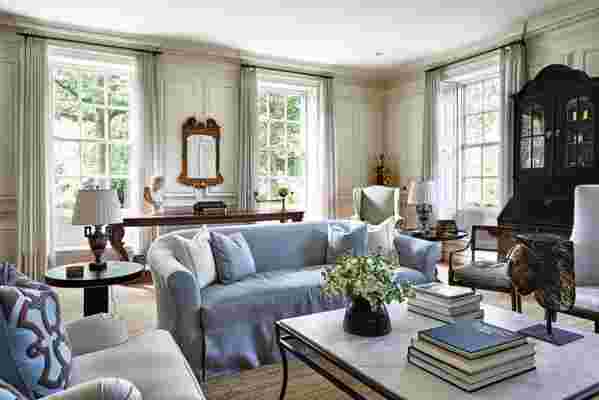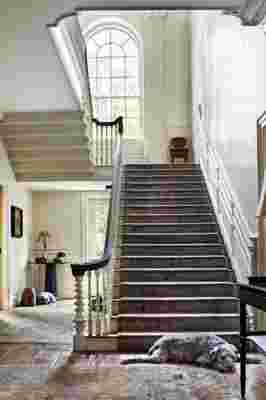The Kalorama neighborhood of Washington, D.C., is known for its elegant homes—the Obamas moved in post–White House—but even among the rarefied real estate here, there is one house that has no equal. The Berman family home is not only impressive from the outside, with its neoclassical lines and taupe-and-cream color scheme, but it also has a provenance like no other address in the entire city. The 8,000-square-foot-plus estate was originally located in Danvers, Massachusetts, and, with a build date of 1754, it is the oldest home in all of D.C. “Robert ‘King’ Hooper, a merchant who was loyal to the British, built it and eventually loaned it to General Gage, a British general and governor who used it as his headquarters for about six months during the Revolutionary War,” says author Alice Berman, who splits her time between the home here and New York City. “That’s how the musket hole ended up in the front door: Someone shot at him.”
Hooper eventually lost the house to creditors, and at one point the home was even turned into a girls’ boarding school. Famed antique dealer Israel Sack also had his hand in the property: “He dismantled the paneled living room and sold it to a museum in Kansas. I always laugh to think that our living room is exactly replicated somewhere,” Berman says. The house was saved from complete demolition by George and Miriam Morris, who dismantled the whole property, numbered each piece, and had it shipped to D.C. on railcar in the 1930s. “They even asked Mr. Sack to re-create the exact paneled living room he had sold,” Berman adds.

Decorating firm Simon-Wallace designed the living room, but many of the pieces are antiques that have been in the family for years.
But, by the time Alice Berman’s parents, Wayne and Lea Berman, bought the home about five years ago, it had fallen into fairly serious neglect. “There was mold infesting every room: underneath the floorboards and behind the wallpaper,” Berman says. The renovation project took nearly a year; all to ensure that the home’s incredible history could be enjoyed for many decades to come. “It was really important to all of us to maintain the unique character of the house but still make it contemporary and livable,” Berman says.
The result is a manse that shows off its incredible bones—intricate crown molding, wide foyers and landings—but has been updated for life in the 21st century. The living room, for example, is a perfect meeting of new and old: cream-colored paneled walls share space with a piece from contemporary artist Louise Despont. And while decorating firm Simon-Wallace Design aided Berman with this room, Alice’s mother, Lea, took the reins on the rest of the home. “In every house we’ve had, we always have what we call the study, which is essentially our family room,” Berman says. “My mother decorates it the exact same way, right down to the painting technique on the walls and the green velvet couch. That was one of the first rooms we did, because it’s such an important part of our family—it makes you feel at home instantly.”

The home’s foyer features an exceptionally spacious staircase, with a runner rug sourced from David Zadeh.
And for Berman, the home’s own story has sparked many an idea for her writing. “It’s always fascinating to hear about the history of the house; the little bathrooms were wig-powdering closets,” she says. “And everyone who's lived there has really documented it so carefully. When we moved in, we were given these binders of old photos of what the house looked like, lists of the people who visited, and the attendees of the different parties.” Other invaluable heirlooms include menus and invitations that Miriam Morris saved, and a set of dining room chairs that have been passed down from owner to owner, starting from the 1800s. “I just loved the idea of thinking about, ‘How many Christmases have they had in this library? What did it used to be like to heat the house?’ Because it has so many fireplaces, it reminds you of the fact that there wasn't central heating for a long time,” she says.
The ultimate resource for design industry professionals, brought to you by the editors of Architectural Digest

Berman’s latest book, I Eat Men Like Air , comes out this month and was written almost entirely in the house. “I love writing in the study. We have this big, cozy, green couch in there and I always have a dog on either side,” she says. “I’ll be wrapped up in the blankets, writing for hours and hours and have no idea the time is passing.” The home’s New England birthplace was also a touchstone for the novel, whose plot takes place partially in that area. “I knew I wanted to set as much of the book as I could in New England, because I think there's a Gothic element to it,” Berman says. “You're sort of in the middle of nowhere, but it's also very elegant and refined. And our house reminds me of that because it's had this very strange life. So, that was really inspirational to me.”
